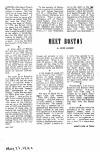
Home Page Meet Boston Menu Index
|
MEET BOSTON Friday, May 22, 1942 in What's New In Town W. J. Sidis |
Boston’s Old North Church and Old South Church are famous in history. But how many of us know there was an Old West Church? It was put there to serve what used to be called West Boston (now the West End). During the siege of Boston, in 1775, the British militia cut down the tall steeple of the Old West on the grounds that it might be used to signal the rebels in Cambridge. But the Old West went on, without its steeple, and, over a hundred years later, was rebuilt in brick. It is now the West End branch of the Public Library.
*
In some parts of Beacon Hill one can almost get the illusion of an 18th century city―and yet nothing on the Hill is as old as that, except the State House and a few buildings east of it. All of Beacon Hill westerly of the State House was settled shortly before the Civil War, but built in a good imitation of colonial architecture.
*
The south tip of Brookline is a region that was built up only within the last ten years or so. In colonial time it was reputed to be the hangout of idlers who, so ran the belief, of the more “respectable” townspeople in “the Village,” never did any work, but spent their time “puttering about.” And so this region is still called Putterham. The other end of Brookline (the shore of the Charles) was set up in the depression year of 1837 as a shantytown, a project of those days for housing the unemployed. But such a name as “shanty” being too undignified, the buildings were entitled cottages, and the settlement was called Cottage Farm, the name still applied to that bit of riverfront.
*
To the west of Boston there is a group of municipalities with names beginning with W―Watertown Waltham, Weston, Wellesley, and Wayland. There is even a contiguous part of Newton called Waban. And, to the north of Boston, there is similarly a group of M’s―Malden, Medford, and Melrose. While Winchester borders on Woburn and Wakefield, though not actually in contact with them, is in the same neighborhood. There is another M group in the state, though not too close to the Metropolis, namely, Medway, Medfield, Millis, and Milford.
*
In the tangle of woods still to be found in the “crater” section of West Roxbury, there is a path labelled Quirk Street. This was originally planned as a street knotting itself into a genuine pretzel shape. But fortunately that plan was never carried out.
*
We have all hears the alleged Cape Cod remark, “Them ain’t clams, them’s cohawgs.” But how many of us could identify a “cohoss” if we saw one? Yet “cohoss” was once a common bit of geographical description here about, suitable to just such hilly country as is to be found around Boston. It is an Algonquin term denoting a notch where a river cuts between two hills. In old Western Massachusetts documents, “cohoss” is used to refer to the notch in the Holyoke Range (now called Thermopylae) where the Connecticut passes through. And, as the northern end of New Hampshire is the home of the “cohoss,” it is not surprising to find it called Coos County. While an Algonquin tribe, strayed out to the mountainous Pacific Coast, uses this same title. The Iroquois equivalent was Skanetade―a name they applied to Albany and the Hudson River, and still surviving in the name Schenectady, while the word “cohoss” appears there in the name of Cohoes. On the South Shore, most of which is low and flat, a bit of high ground appears just below Nantasket, and, where a couple of small streams cut their way through to the sea, we again have cohoss country―Cohasset.
*
The boundary between Brookline and Boston’s West Roxbury district, though about five miles long, is crossed by no public transportation routes. This border is more closely approached by transit from the Brookline side than from the Boston side.
*
Street mailboxes were first introduced to the world in Boston’s streets, back in 1855. Before that, letters had to be mailed in a postoffice or entrusted to a postman―and branch postoffices were not so plentiful in those days, either.